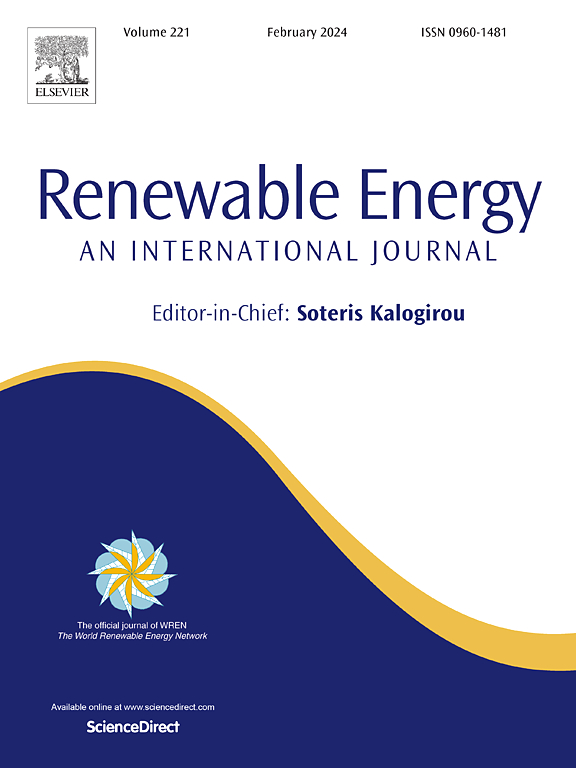Boosting bioelectricity performance in sediment microbial fuel cells with raw bamboo biochar as a sustainable energy source
IF 9
1区 工程技术
Q1 ENERGY & FUELS
引用次数: 0
Abstract
Sediment microbial fuel cell (SMFC) is a sustainable technology to generate bioelectricity for bioenergy production. In this study, bamboo biochar is mixed with coastal benthic sediment from oyster farm as conductive aid to optimize SMFC capacity for bioelectricity production. Laboratory-scale SMFCs are constructed with different biochar dosages, including control (SMFC-P0) and biochar cases (SMFC-P5, SMFC-P10 and SMFC-P20), to confirm the effect of biochar on bioelectricity generation and carbon sequestration. Operating SMFCs with a moderate dosage of bamboo biochar in SMFC-P5 (5g biochar) and SMFC-P10 (10g biochar) reduces internal resistance by 29.8 % and 57.5 %, resulting in high output voltage for SMFC-P5 (23 mV) and SMFC-P10 (68 mV), with a 1.3 and 3.2-fold increase, respectively. SMFC-P10 achieves maximum power density of 19.7 mW/m2 with optimal biochar addition in anodic region, enhancing overall SMFC performance due to reduction in ohmic resistance. SMFC-P10 exhibits the highest redox activity, resulting in the highest current response during initial (10.4 mA) and final (8.22 mA) cyclic voltammetry. High electrode capacitance due to biochar addition minimizes charge transfer resistance, improving electron transfer. Anodic biofilm thrives under moderate biochar dosages below 2 %. Biochar addition reduces sediment CO2 emissions, indicating that it improves soil quality and effectively sequesters soil carbon.
以竹炭为可持续能源提高沉积物微生物燃料电池的生物电性能
沉积物微生物燃料电池(SMFC)是一种用于生物能源生产的可持续生物发电技术。在本研究中,将竹生物炭与牡蛎养殖场的沿海底栖生物沉积物混合作为导电剂,以优化SMFC的生物电生产能力。构建了不同生物炭用量的实验室规模的smfc,包括对照(SMFC-P0)和生物炭组(SMFC-P5、SMFC-P10和SMFC-P20),以确定生物炭对生物发电和固碳的影响。在SMFC-P5 (5g生物炭)和SMFC-P10 (10g生物炭)中添加适量的竹炭可使SMFC-P5和SMFC-P10的内阻分别降低29.8%和57.5%,使SMFC-P5和SMFC-P10的输出电压分别达到23mv和68mv,分别提高1.3倍和3.2倍。通过在阳极区添加最佳生物炭,SMFC- p10实现了19.7 mW/m2的最大功率密度,由于降低了欧姆电阻,提高了SMFC的整体性能。SMFC-P10表现出最高的氧化还原活性,在初始(10.4 mA)和最终(8.22 mA)循环伏安法中产生最高的电流响应。由于添加生物炭而产生的高电极电容使电荷转移阻力最小化,从而改善了电子转移。阳极生物膜在低于2%的适度生物炭用量下生长。添加生物炭可减少沉积物CO2排放,表明其改善了土壤质量,有效地固碳。
本文章由计算机程序翻译,如有差异,请以英文原文为准。
求助全文
约1分钟内获得全文
求助全文
来源期刊

Renewable Energy
工程技术-能源与燃料
CiteScore
18.40
自引率
9.20%
发文量
1955
审稿时长
6.6 months
期刊介绍:
Renewable Energy journal is dedicated to advancing knowledge and disseminating insights on various topics and technologies within renewable energy systems and components. Our mission is to support researchers, engineers, economists, manufacturers, NGOs, associations, and societies in staying updated on new developments in their respective fields and applying alternative energy solutions to current practices.
As an international, multidisciplinary journal in renewable energy engineering and research, we strive to be a premier peer-reviewed platform and a trusted source of original research and reviews in the field of renewable energy. Join us in our endeavor to drive innovation and progress in sustainable energy solutions.
 求助内容:
求助内容: 应助结果提醒方式:
应助结果提醒方式:


